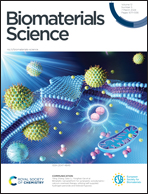A quaternary ammonium-based nanosystem enables delivery of CRISPR/Cas9 for cancer therapy†
Abstract
Genome editing mediated by CRISPR/Cas9 is an attractive weapon for cancer therapy. However, in vivo delivery of CRISPR/Cas9 components to achieve therapeutic efficiency is still challenging. Herein, a quaternary ammonium-functionalized poly(L-lysine) and a cholesterol-modified PEG (QNP) were self-assembled with a negatively charged CRISPR Cas9/sgRNA ribonucleoprotein (RNP) to form a ternary complex (QNP/RNP). Such a delivery system of QNP exhibited multiplex genome editing capabilities in vitro (e.g., the GFP gene and the PLK1 gene). In addition, QNP/RNPPLK1 containing PLK1 sgRNA led to 30.99% of genome editing efficiency in MCF-7 cells with negligible cytotoxicity of the carrier. QNP/RNPPLK1, which was capable of simultaneously inhibiting cell proliferation, mediating cell cycle arrest and downregulating expression of PLK1, held great in vitro therapeutic efficiency. Moreover, QNP/RNPPLK1 exhibited outstanding accumulation in tumors and high biocompatibility in vivo. In an MCF-7 xenograft animal model, QNP/RNPPLK1 showed excellent anti-tumor efficacy and achieved 17.75% indels ratio. This work showcases the successful delivery of CRISPR Cas9/sgRNA RNP with enhanced genome editing efficiency and provides a potential on-demand strategy for cancer therapy.

- This article is part of the themed collections: World Cancer Day 2025: Showcasing cancer research across the RSC and Biomedical Polymer Materials


 Please wait while we load your content...
Please wait while we load your content...